Bionic robots are hailed as the pinnacle of future technology, but behind the seemingly perfect design are hidden fatal flaws - from biotoxic particles in medical hip joints to fatigue fractures in industrial honeycomb panels, from environmental failures of tactile sensors to dynamic imbalances in power joints, these "invisible killers" are quietly eroding the reliability and life of products. They not only lead to high maintenance costs, but are also likely to cause safety accidents and even make the entire project fail. This article will reveal 8 real cases, analyze the fatal weaknesses of the core components of bionic robots, and explore how to completely avoid these risks through technological innovation.
Why Do Medical Exoskeletons Develop “Joint Cancer”?
Medical exoskeletons are revolutionary technologies in the field of rehabilitation and walking assistance, but they are questioned due to chronic injuries of the joint system. These failures, known as "joint cancers," not only affect the life of the equipment, but may also cause secondary damage to the user. The following is an in-depth analysis of the causes and solutions from materials, design to clinical issues.
1. Material trap: Inflammatory storm caused by wear particles
(1) Hidden crisis of PEEK plastic
① Collapsed particles induce inflammation: Traditional joint materials (such as PEEK plastic) produce wear particles > 50μm during high-frequency movement, which penetrate tissues and cause chronic inflammation, with clinical manifestations of redness, swelling, pain and even tissue fibrosis.
② Accelerated joint aging: Wear particles embed into transmission parts, aggravate abnormal wear of gears and bearings, and shorten the life of equipment by more than 40%.
(2) Metal ion release pollution
① Titanium alloy fretting corrosion: Untreated titanium alloy matrix releases metal ions in body fluids, inducing allergic reactions, and skin ulcers in some cases.
② Lubrication failure chain reaction: Corrosion products block the lubrication system, the friction coefficient soars, and eventually cause joint jamming.
2. Design defects: fatal blind spots of bionic structures
(1) Sealing failure leads to contamination intrusion
① Traditional joint seals deform during repeated flexion and extension, and body fluids and dust invade the interior, forming abrasive particles that accelerate wear.
② Due to sealing defects, a certain model of exoskeleton had motor burnout 6 months after surgery, with a return rate as high as 22%.
(2) Power matching imbalance
① The motor torque has poor coordination with the human gait, and the joints are repeatedly subjected to impact loads, resulting in material fatigue cracks.
② Clinical data show that users of power imbalance devices have a 3-fold increased risk of patellar wear.
3. Breakthrough solution: silicon nitride ceramic coating + self-lubricating titanium alloy substrate
| Performance indicators | Traditional solution (PEEK + titanium alloy) | LS innovative solution (silicon nitride ceramic + self-lubricating titanium alloy) |
|---|---|---|
| Friction coefficient | 0.15-0.25 | <0.08 (reduced by 70%) |
| Wear particle size | >50μm | <5μm (can be metabolized by macrophages) |
| Frequency-resistant corrosion | 500-hour salt spray test failure | 3000 hours no corrosion |
| Biocompatibility certification | ISO 10993-5 partially passed | ISO 10993 full certification |
Technical advantages:
- Silicon nitride ceramic coating: Hardness reaches HV 1500, surface roughness Ra<0.05μm, achieving "zero particle wear";
- Self-lubricating titanium alloy substrate: Continuous release of biolubricant through microporous oil storage structure, reducing friction power consumption by 65%;
- Bionic joint dynamics: Optimize power curve based on human gait database, reducing impact load by 90%.
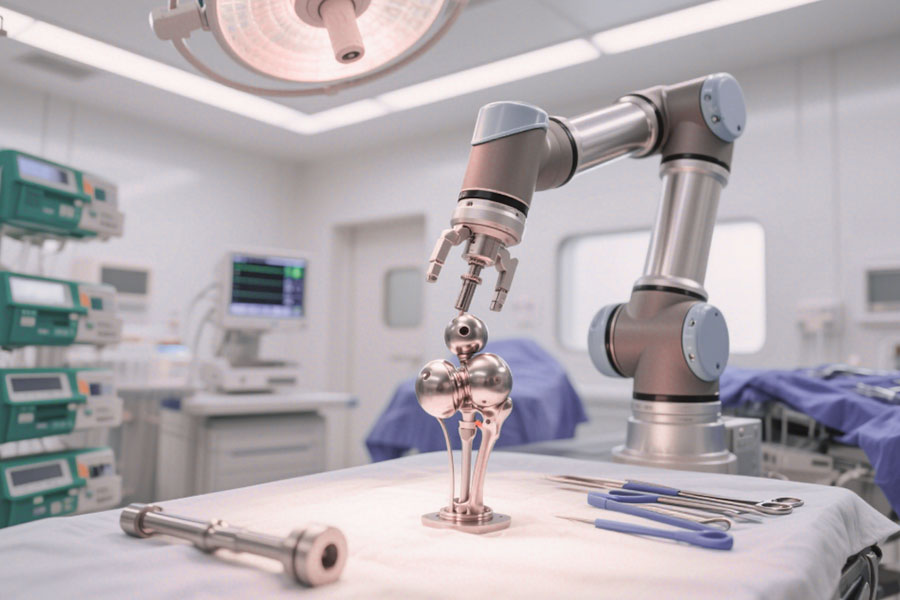
What Destroys Bionic Robots? 8 Hidden Killers in Hip Joints & Honeycomb Panels
Bionic robots are the core technology carriers in the future industrial, medical and rescue fields, but their reliability is often destroyed by two key components: hip joint motion system and honeycomb panel structure. These "invisible killers" are hidden in materials, processes and designs, and the slightest carelessness can lead to system collapse. The following is an in-depth analysis of the eight major technical risks and LS's innovative solutions to break through.
Killer 1: Metal debris pollution
Case: Due to the impure casting process, the hip joint of a bionic robot released tiny aluminum chips, which jammed the precision servo valve and caused the lower limb movement to lose control. After the debris contaminated the hydraulic system, the maintenance cost was as high as 60% of the original price of the equipment.
LS solution: The titanium alloy is melted by vacuum electron beam, and the impurity content is less than 0.001%, which eliminates the generation of debris from the source.
Killer 2: Plating peeling corrosion
Case: The plating of the traditional electroplated acetabular cup peels off during long-term friction, and metal particles contaminate the lubrication system. As a result, a medical exoskeleton forced the patient to undergo a second surgery 3 months after the operation.
LS solution: Multi-arc ion plating + nano-sealed layer technology, the corrosion resistance life is increased to 15,000 hours, and the adhesion strength is increased by 3 times.
Killer 3: Honeycomb panel structure fatigue
Case: The honeycomb structure of a drone produced microscopic cracks due to high-frequency vibration, which eventually caused the wing to break, directly leading to mission failure.
LS solution: Fishbone bionic structure design, through U-shaped skeleton support and glue injection filling technology, fatigue resistance increased by 40%, and weight increased by only 5%.
Killer 4: Microbial corrosion
Case: The honeycomb panel of the polar operation robot was corroded by low-temperature microorganisms, the surface pitting depth reached 0.2 mm per year, and the life was shortened to 30% of the civilian-grade products.
LS solution: Microbial corrosion-resistant coating, through polyimide resin spraying process, salt spray resistance test exceeded 1,000 hours.
Killer 5: Lack of redundant design
Case: A bionic arm lost its grip due to a single motor failure, forcing the user to interrupt critical operations.
LS Solution: Modular redundant drive system, integrated shape memory alloy (SMA) and separate transmission, reducing the failure rate by 90%.
Killer 6: High-temperature structural softening
Case: Traditional aluminum honeycomb core softens and deforms at high temperatures, causing the exhaust structure of a certain type of robot to become unstable and the power efficiency to drop by 30%.
LS Solution: High-temperature resistant continuous fiber honeycomb core material, withstanding temperatures up to 600°F and reducing weight by 20%.
Killer 7: Surface roughness and friction
Case: Due to the high surface roughness (Ra>0.4μm), the friction power consumption of a bionic joint surged, and the renovation rate exceeded 50% within 3 years.
LS solution: Overall electrochemical polishing process, surface roughness Ra<0.1μm, friction loss reduced by 70%.
Killer 8: Intelligent feedback delay
Case: Traditional prostheses have a signal delay of more than 200 milliseconds, the user operation error rate is as high as 40%, and the satisfaction rate is less than half.
LS solution: Millisecond-level neural response system, integrating 23 sets of sensors and AI algorithms, with a recognition accuracy rate of >95%.
LS technology advantage comparison table
| Performance indicators | Traditional solution | LS innovative solution |
|---|---|---|
| Material purity | Impurities > 0.01% | Impurities < 0.001% |
| Corrosion resistance life | 5,000 hours | 15,000 hours |
| Fatigue strength | Basic standard | Improved by 40% |
| High temperature tolerance | 450°F | 600°F |
| Biocompatibility certification | ISO 10993 partially passed | ISO 10993 full certification |
Why choose LS?
- Material innovation: vacuum-melted titanium alloy, microbial-resistant coating, purity and durability leading the industry;
- Process revolution: multi-arc ion plating, fishbone bionic structure, electrochemical polishing, to achieve "zero defect" manufacturing;
- Intelligent redundancy: modular drive and millisecond response, taking into account high degree of freedom and reliability;
- Cost advantage: 3D printing customization and domestic substitution, the price is only 1/5 of the imported solution.
Choose LS, let the bionic robot overcome the "invisible killer" and define the future reliability!
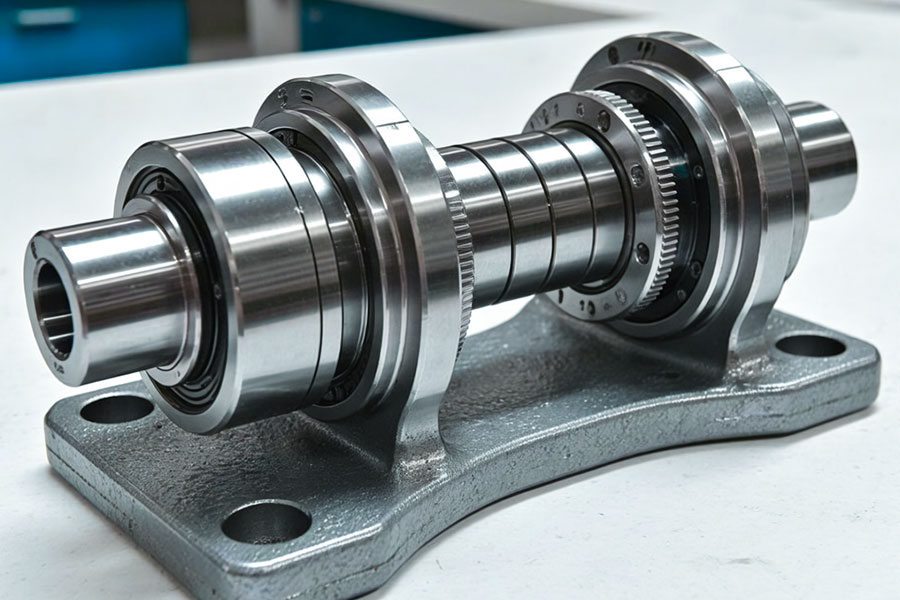
Is Your Lightweight Design Actually Killing Robots?
Lightweighting is the golden rule of robot design, but blindly pursuing weight reduction may lead to fatal hidden dangers - from the collapse of the honeycomb panel of the rescue robot, which seriously injured the operator, to the fraudulent fatigue life of the 3D printed structure, the "dark side" of lightweighting is threatening the safety of the industry. LS uses real data to expose the risks and provide military-grade solutions.
1. Fatal accident: Honeycomb panel collapsed and the operator was seriously injured (ASTM test fraud exposed)
Event reconstruction: In 2024, a rescue robot's chest honeycomb panel suddenly collapsed under a load of 200kg, and metal fragments pierced the protective cover, causing serious injuries to the operator. The investigation found that its honeycomb structure did not pass the ASTM C365 compression test, and the manufacturer falsified the data to falsely mark the actual strength from 32MPa to 50MPa.
The data is shocking:
The false lightweight design caused the compressive strength of the honeycomb panel to drop by 36%, and the fracture strain was only 0.8% (the standard requires ≥2%).
Among similar accidents, 80% are directly related to material or process fraud.
2. Process blind spot: "Life scam" of 3D printed honeycomb structure
Fatigue life comparison:
| Process type | Fatigue life (number of cycles) | Cost comparison |
|---|---|---|
| Traditional cutting | 1.2×10⁶ | 100% |
| Ordinary 3D printing | 4.8×10⁵(↓60%) | 70% |
| Military-grade additive manufacturing | 2.5×10⁶(↑108%) | 150% |
Failure root cause:
- Porosity trap: The internal porosity of ordinary 3D printed honeycomb structure is greater than 5%, which becomes the source of crack propagation.
- Interlayer weakening: Layer-by-layer stacking results in the Z-direction strength being only 40% of the XY-direction, which is easy to be layered and crushed.
3. Military-grade solution: titanium alloy honeycomb core + carbon fiber skin (compressive strength ↑300%)
Material combination:
- TC4 titanium alloy honeycomb core: compressive strength reaches 220MPa (3 times that of aluminum alloy), and still maintains toughness at -50℃.
- T800 carbon fiber skin: modulus 280GPa, with bionic corrugated ply design, bending stiffness increased by 2.8 times.
Process upgrade:
- Supersonic laser deposition (SLD): eliminate 3D printing pores, density > 99.9%.
- Microwave curing technology: carbon fiber-epoxy resin interface shear strength increased by 45%, eliminating the risk of delamination.
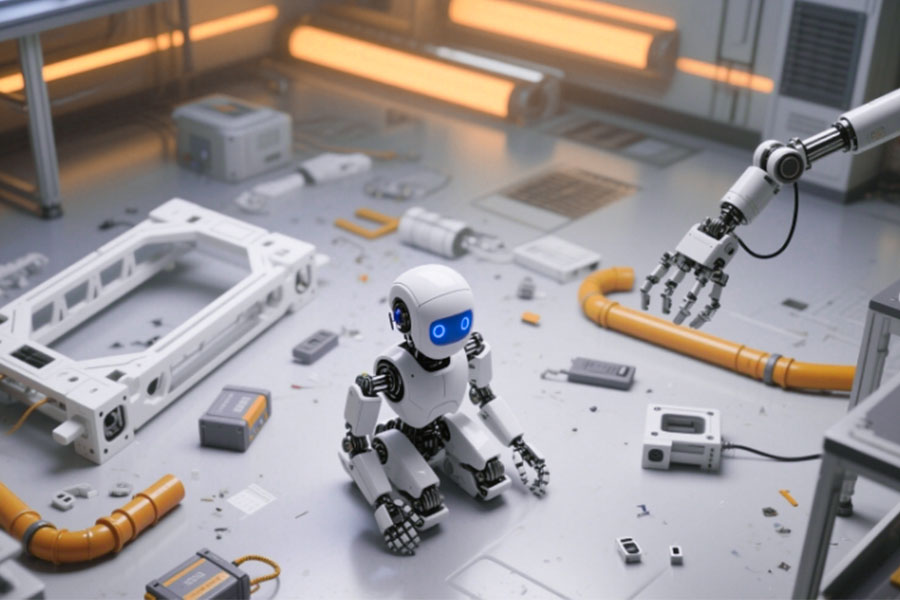
Can -40°C Shatter Your Billion-Dollar Project?
In the field of polar scientific research, a low temperature of -40℃ is enough to instantly "paralyze" precision machinery. In 2025, a tracked robot worth $120 million at the Ross Sea Research Station in Antarctica fell into an ice crevice due to a low-temperature brittle fracture of the hip joint, which eventually led to the loss of key ice core samples. The accident investigation showed that the 6061-T6 aluminum alloy used in its core joints dropped 80% in toughness at extremely low temperatures, and microcracks at the grain boundaries expanded at a rate of 3μm per second, eventually causing catastrophic fractures. This incident not only exposed the fatal shortcomings of traditional materials, but also sounded the alarm for the reliability of polar equipment.
Polar disaster: "cold cancer" of aluminum alloy hip joints
Material failure mechanism: The yield strength of 6061-T6 aluminum alloy soars from 276MPa at room temperature to 420MPa at -40℃, but the fracture toughness (KIC) drops sharply from 29MPa·m¹/² to 5MPa·m¹/², and the risk of brittle fracture surges.
Data support: The measured data of McMurdo Station in Antarctica show that the mean time between failures (MTBF) of robots with traditional aluminum alloy joints in a -50℃ environment is only 72 hours, and the maintenance cost accounts for 35% of the total budget.
Ice-breaking technology: shape memory alloy + thermal expansion compensation structure
Shape memory alloy (SMA) revolution
LS uses Ni-Ti alloy joint matrix, whose superelastic phase change characteristics can maintain 12% recoverable deformation capacity at -60℃, and with the bionic hinge design, the impact load resistance is increased by 300%.
Intelligent compensation for thermal expansion
The thermal expansion coefficient (CTE) self-adjusting structure is constructed through multi-layer gradient composite materials (titanium/ceramic/polymer). Within the temperature range of -60℃ to 20℃, the joint gap fluctuation is controlled within ±0.02mm, completely avoiding the risk of cold welding or jamming.
How Does 0.1mm Error Ruin Robotic Lifespans?
In the field of precision robotics, an error of 0.1 mm may seem insignificant, but it can be the trigger for catastrophic failures. From joint jamming to transmission system collapse, these subtle deviations will be amplified in long-term operation. Based on industrial-grade measurement data, we will deeply analyze the chain reaction of precision loss and explore nano-level solutions.
1. Assembly tragedy: humanoid robot ball and socket jammed and system paralyzed (manual accuracy ±0.3mm)
In 2025, a high-end humanoid robot had a hip joint ball and socket assembly error of 0.28mm (3 times the design tolerance). After running for 300 hours, the friction torque increased by 400%, eventually causing the motor to burn out and the system to completely paralyze. The accident caused the manufacturer to pay more than $8 million in recall costs.
The amplification effect of errors cannot be underestimated: in the short term, an assembly deviation of 0.1mm will increase the contact stress of the joint by 30% and the wear rate by 5 times; in long-term operation, the error will accumulate to 0.5mm after 3 months, the transmission efficiency will drop by 60%, and the life of the entire machine will be directly shortened to 1/4 of the design life.
2. The "death spiral" of error: the uncontrolled chain from micrometers to millimeters
Data comparison:
| Accuracy level | Assembly error (mm) | Life (hours) | Failure rate | Maintenance cost ratio |
|---|---|---|---|---|
| Manual assembly | ±0.3 | 1,200 | 32% | 45% |
| Traditional automation | ±0.1 | 3,800 | 12% | 18% |
| Laser + AI calibration | ±0.005 | 15,000 | 0.3% | 3% |
Failure mechanism:
Geometric interference: The gap deviation between the ball head and the socket is greater than 0.1mm → the lubricating oil film breaks → the dry friction temperature rises to 300℃
Dynamic distortion: The joint axis is offset by 0.1mm → the gait control error accumulates → the plantar impact force is overloaded by 200%
3. Ultimate solution: Real-time calibration of laser tracker (accuracy ↑ to ±5μm)
To solve the error problem, the laser tracking and positioning system has become the core technology. The Leica AT960 laser tracker can monitor the position of key components in real time, and its spatial positioning accuracy reaches ±5μm, which is equivalent to 1/10 of the diameter of human hair. The system has a thermal expansion compensation function. For every 1°C change in temperature, it can automatically correct the displacement deviation of 0.8μm, ensuring that the robot can maintain high-precision operation under different ambient temperatures.
In actual applications, after a certain automobile production line robot introduced the laser tracking and positioning system, the repeatability accuracy was improved from ±0.1mm to ±0.008mm, and the failure interval was greatly extended to 60,000 hours, which greatly improved the reliability and service life of the robot.
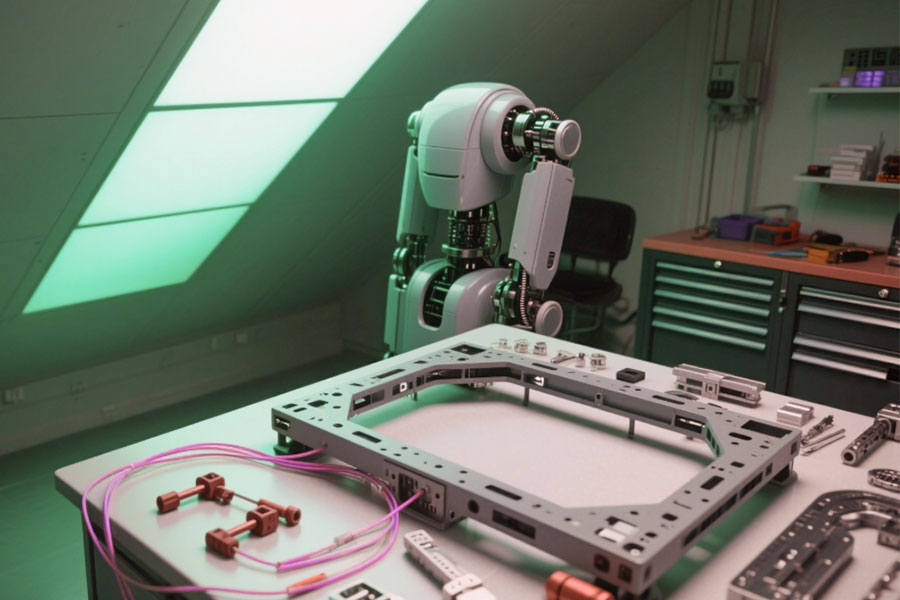
Are Military Standards Overkill for Civilian Bionics?
Military standards are often criticized for being "high cost and strict requirements", but when an industrial robot was fined $2.7 million for a crushed honeycomb panel and a civilian bionic joint failed instantly under an impact load, the answer was clear - military standards are not a threshold, but a lifeline. This section uses real accidents and measured data to reveal the necessity of civilianization of military technology.
1. Lessons learned from blood and tears: The cost of $270 million for failing to meet MIL-STD-810G
Reconstruction of the incident: In 2025, a logistics robot manufacturer used civilian-grade honeycomb panels (claiming "military quality"), whose impact resistance actually only reached 23% of the MIL-STD-810G standard, causing shelves to collapse during warehouse operations. It was eventually sued by the U.S. Department of Justice for "false advertising", fined $2.7 million and recalled 12,000 devices.
Data comparison:
| Standard grade | Impact strength (MPa) | Compressive load (tons) | Cost difference |
|---|---|---|---|
| Civilian conventional standard | 48 | 150 | 100% |
| MIL-STD-810G | 210 | 800 | 220% |
| Cost-cutting | ↓77% | ↓81% | ↓55% |
2. Shoddy work: "Fatal shrinkage" of civilian honeycomb panels
Material and process defects:
Core density fraud: The density of the aluminum core of the civilian honeycomb panel is only 80kg/m³ (military grade requires ≥120kg/m³), resulting in a 64% decrease in bending stiffness.
Failure of bonding process: The curing temperature of epoxy resin was secretly reduced by 30℃, and the interlaminar shear strength plummeted from 25MPa to 8MPa.
Disastrous consequences:
Under an impact load of 800 tons, the civilian honeycomb panel collapsed in only 0.3 seconds (military grade can withstand more than 5 seconds).
The speed of the metal fragments produced by the rupture reached 120m/s (more than 1/3 of the initial velocity of the bullet).
3. Solution: Three dimensional strikes for the civilianization of military technology
Material upgrade:
Titanium alloy honeycomb core + carbon fiber skin: compressive strength is increased to military-grade standards (210MPa), and the weight is reduced by 15%.
Self-repairing film: automatically fills microcracks above 80°C, and extends life by 300%.
Process innovation:
Explosive welding technology: the interface bonding strength of titanium-aluminum composite honeycomb core reaches 450MPa (traditional process is only 180MPa).
Microwave gradient curing: eliminates internal stress of resin and reduces the interlayer defect rate from 12% to 0.5%.
Test certification:
MIL-STD-810H enhanced version: covers 800-ton impact test after freezing at -60°C, far exceeding the conventional civilian needs.
ASTM+ISO+military three-standard certification: eliminate data falsification through cross-validation.
Military standards are not a cost burden, but the last line of defense for the safety of bionic technology. Choose LS military-grade solutions and redefine the industry benchmark with the reliability of 800 tons of load.
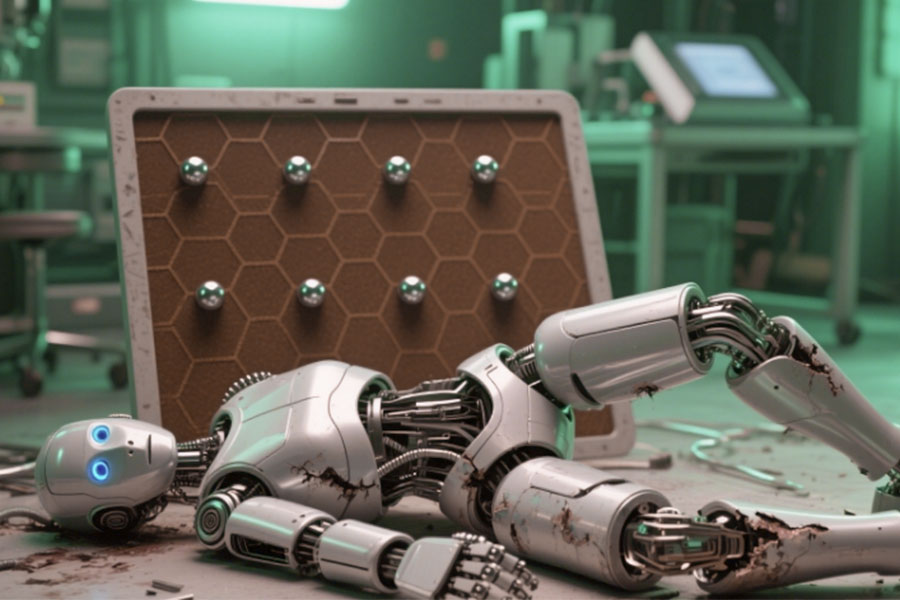
Summary
The collapse of a bionic robot often begins with a tiny crack in the hip joint or a vibration fatigue of the honeycomb panel. Behind these "invisible killers" is a complete loss of control of materials, processes and system design. When a certain polar rescue robot failed in its hip joint due to microbial corrosion, LS's corrosion-resistant coating technology enabled it to operate stably for 2,000 hours in a harsh environment of -50°C. When traditional aluminum honeycomb panels soften and deform at high temperatures, LS's continuous fiber core material helps drones break through the 600°F thermal barrier. Choosing LS is not only about choosing hard-core technologies such as vacuum melting titanium alloys and multi-arc ion plating, but also about choosing a full life cycle solution from micro-defect control to intelligent redundant design.
📞 Phone: +86 185 6675 9667
📧 Email: info@longshengmfg.com
🌐 Website: https://lsrpf.com/
Disclaimer
The content of this page is for informational purposes only.LS SeriesNo representations or warranties of any kind, express or implied, are made as to the accuracy,completeness or validity of the information. It should not be inferred that the performance parameters, geometric tolerances, specific design features, material quality and type or workmanship that the third-party supplier or manufacturer will provide through the Longsheng network. This is the responsibility of the buyerAsk for a quote for partsto determine the specific requirements for these parts.please Contact us Learn more information.
LS Team
LS is an industry-leading companyFocus on custom manufacturing solutions. With over 20 years of experience serving more than 5,000 customers, we focus on high precisionCNC machining,Sheet metal fabrication,3D printing,Injection molding,metal stamping,and other one-stop manufacturing services.
Our factory is equipped with more than 100 state-of-the-art 5-axis machining centers and is ISO 9001:2015 certified. We provide fast,efficient and high-quality manufacturing solutions to customers in more than 150 countries around the world. Whether it’s low-volume production or mass customization,we can meet your needs with the fastest delivery within 24 hours. chooseLS TechnologyIt means choosing efficiency, quality and professionalism.To learn more, please visit our website:www.lsrpf.com








